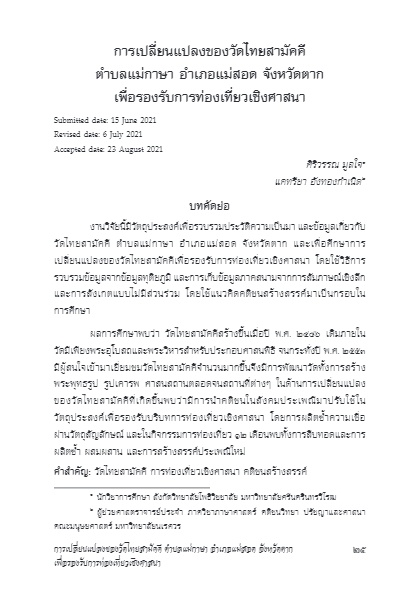การเปลี่ยนแปลงของวัดไทยสามัคคี ตำบลแม่กาษา อำเภอแม่สอด จังหวัดตาก เพื่อรองรับการท่องเที่ยวเชิงศาสนา
ศิริวรรณ มูลใจ
แคทรียา อังทองกำเนิด
บทคัดย่อ
งานวิจัยนี้มีวัตถุประสงค์เพื่อรวบรวมประวัติความเป็นมา และข้อมูลเกี่ยวกับวัดไทยสามัคคี ตำบลแม่กาษาอำเภอแม่สอด จังหวัดตาก และเพื่อศึกษาการเปลี่ยนแปลงของวัดไทยสามัคคีเพื่อรองรับการท่องเที่ยวเชิงศาสนา โดยใช้วิธีการรวบรวมข้อมูลจากข้อมูลทุติยภูมิ และการเก็บข้อมูลภาคสนามจากการสัมภาษณ์เชิงลึก
และการสังเกตแบบไม่มีส่วนร่วม โดยใช้แนวคิดคติชนสร้างสรรค์มาเป็นกรอบในการศึกษา
ผลการศึกษาพบว่า วัดไทยสามัคคีสร้างขึ้นเมื่อปี พ.ศ. ๒๔๘๖ เดิมภายในวัดมีเพียงพระอุโบสถและพระวิหารสำหรับประกอบศาสนพิธี จนกระทั่งปี พ.ศ. ๒๕๕๓มีผู้สนใจเข้ามาเยี่ยมชมวัดไทยสามัคคีจำนวนมากขึ้นจึงมีการพัฒนาวัดทั้งการสร้างพระพุทธรูป รูปเคารพ ศาสนสถานตลอดจนสถานที่ต่างๆ ในด้านการเปลี่ยนแปลง
ของวัดไทยสามัคคีที่เกิดขึ้นพบว่ามีการนำคติชนในสังคมประเพณีมาปรับใช้ในวัตถุประสงค์เพื่อรองรับบริบทการท่องเที่ยวเชิงศาสนา โดยการผลิตซ้ำความเชื่อผ่านวัตถุสัญลักษณ์ และในกิจกรรมการท่องเที่ยว ๑๒ เดือนพบทั้งการสืบทอดและการผลิตซ้ำผสมผสาน และการสร้างสรรค์ประเพณีใหม่
คำสำคัญ: วัดไทยสามัคคี, การท่องเที่ยวเชิงศาสนา, คติชนสร้างสรรค์
(ตีพิมพ์ใน วารสารไทยศึกษา ปีที่ 17ฉบับที่ 2 (กรกฏาคม -ธันวาคม 2564) หน้า 25-49 )
Changes at Wat Thai Samakkhi in Mae Kasa Sub-District Mae Sot District, Tak Province to Accommodate Religious Tourism
Siriwon Moonjai
Catthaleeya Aungthongkamnerd
Abstract
This research aimed to collect historical background and information on Wat Thai Samakki at Mae Kasa Sub-district, Mae Sot District, Tak Province and to study changes made to the temple in order to accommodate religious tourism. The data was collected from secondary sources, indepth interviews conducted during a field trip and non-participant observations, employing
creative folklore as a frame of study.
The results revealed that Wat Thai Samakkhi was built in 1943. At that time, there was only a main hall (Phra Ubosot) and a meeting hall Phra Viharn) for performing rituals and ceremonies. It was not until 2010 that the temple became well-known and was visited by an increasing number
of tourists. Since then, several changes have been made to the temple,including the construction of Buddha images, statues and buildings. The research found that folk culture was directly applied to accommodate people’s need for religious trips; for example, the reproduction of traditional beliefs through symbols and material objects and the attempts to preserve cultures,blend the old and new and create new traditions in organizing a wide range of activities for tourists throughout the year.
Keywords: Wat Thai Samakkhi, Religious Tourism, Creative Folklore
Published in Journal of Thai Studies Volume 17 Number 2 (July – December 2021) Page 25-49)
บทความ/Fulltext:2_Siriwon.pdf
